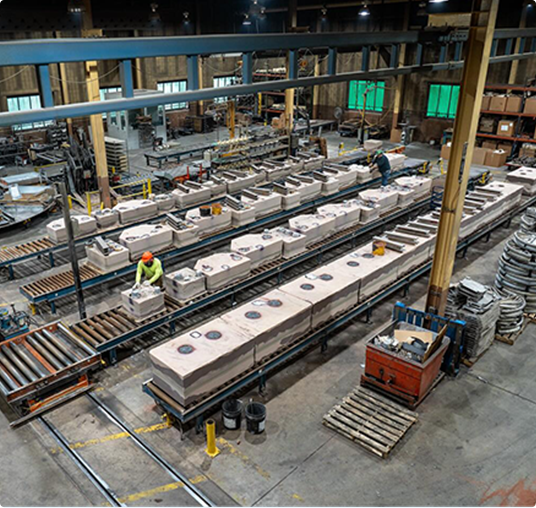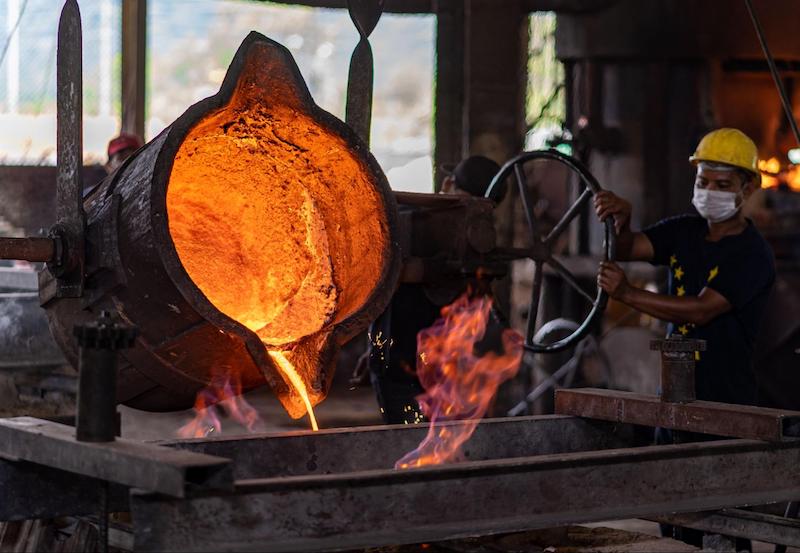How Aluminum Castings Enable Sustainable and Eco-Friendly Production Practices
Wiki Article
Discovering the Ingenious Techniques Used in Modern Aluminum Foundries
Modern aluminum foundries are undergoing a considerable improvement via the fostering of cutting-edge techniques. Advanced casting techniques, smart automation, and sustainable methods are improving manufacturing procedures. These improvements not just enhance performance but likewise address ecological issues. As the sector evolves, the combination of electronic technologies plays an important duty. Recognizing these changes is crucial for grasping the future of aluminum manufacturing and its effects for global markets. What lies in advance in this vibrant sector?Advanced Casting Techniques

Furthermore, innovations in thermal control and mold style have contributed to even more regular casting results. These advancements enable better control of cooling down rates, decreasing defects and boosting mechanical buildings. Therefore, makers can produce lightweight yet durable parts, satisfying the increasing needs of numerous markets, including automotive and aerospace, for high-performance aluminum parts.
Smart Automation and Robotics
The combination of smart automation and robotics in aluminum foundries marks a substantial improvement in manufacturing performance. These innovations enable accuracy and consistency in production procedures, drastically minimizing human mistake and improving safety and security. Automated robot systems manage repetitive tasks, such as molding, putting, and air conditioning, permitting human operators to concentrate on even more complicated responsibilities that need crucial reasoning and oversight.Additionally, ai-driven analytics and wise sensing units supply real-time information tracking, helping with anticipating upkeep and minimizing downtime. This causes maximized source allotment and improved energy usage, adding to overall sustainability in production.
The flexibility of robotic systems enables for fast changes to transforming manufacturing demands, enhancing adaptability in production. As foundries significantly take on these innovative modern technologies, they not only enhance operational efficiency but also place themselves as leaders in innovation within the metal casting sector.
Additive Production in Foundries
Changing standard manufacturing techniques, additive manufacturing is reinventing aluminum foundries by allowing the production of complicated geometries that were formerly unattainable. This technique permits for the layer-by-layer construction of parts, greatly reducing product waste and reducing production times. As a result, foundries can generate complex styles that enhance performance and functionality, providing to the expanding demands of various sectors.Additive manufacturing facilitates fast prototyping, enabling engineers to examine and iterate layouts swiftly. This agility not only increases the advancement cycle but additionally aids in determining potential issues prior to full-blown production starts. The combination of advanced products and processes in additive production better improves the mechanical buildings of aluminum components, advertising development in item design. Aluminum foundries that take on these methods place themselves at the center of industry developments, making certain competitiveness in an ever-evolving market landscape.
Lasting Practices and Recycling
Lasting techniques in aluminum foundries are progressively concentrated on enhancing recycling procedures and taking on environmentally friendly casting methods. These developments aim to lower waste and power intake while making best use of using recycled products. As the industry develops, the combination of sustainability right into manufacturing techniques comes to be vital for fulfilling environmental requirements and customer needs.Recycling Process Improvements
As industries progressively identify the ecological impact of waste, aluminum foundries are adopting ingenious reusing procedure renovations to enhance sustainability. These developments focus on decreasing energy consumption and making the most of material recuperation. As an example, numerous foundries are carrying out closed-loop systems that recycle scrap aluminum produced throughout production, minimizing waste and minimizing the need for virgin materials. Advanced sorting innovations, such as computerized optical sorting, boost the separation of different aluminum qualities, raising the effectiveness of the reusing procedure. Furthermore, some foundries are utilizing hydrometallurgical approaches to recuperate aluminum from complicated waste streams. By integrating these improvements, aluminum foundries not just add to a circular economy but additionally minimize their carbon footprint, straightening with worldwide sustainability goals.Eco-Friendly Casting Techniques
While typical casting approaches usually entail significant power usage and material waste, aluminum foundries are significantly embracing environment-friendly casting techniques that focus on sustainability. Methods such as low-pressure die casting, which decreases air discharges, and the usage of water-based mold and mildew launches add to decreased environmental impact. Furthermore, developments in 3D printing modern technology enable for the production of complicated mold and mildews with less product waste. Many foundries are likewise executing closed-loop systems that reuse water and aluminum scrap, further reducing resource usage. By embracing renewable resource sources, such as solar and wind power, these centers enhance their sustainability efforts. In general, the fostering of green methods in aluminum casting not just benefits the atmosphere yet also promotes financial efficiency and advancement within the sector.Enhanced High Quality Control Measures
Improved quality assurance measures in aluminum foundries are increasingly reliant on sophisticated assessment modern technologies and real-time monitoring systems. These advancements make it possible for producers to identify defects early and ensure constant item high quality. By incorporating these devices, foundries can considerably enhance their operational effectiveness and minimize waste.Advanced Assessment Technologies
Advanced evaluation technologies play an important function in making this website certain the quality and reliability of aluminum castings. These innovative approaches consist of non-destructive screening (NDT) techniques such as ultrasonic testing, radiographic testing, and eddy present assessments. Each technique enables in-depth exam of spreadings without endangering their structural honesty. Advanced imaging strategies, such as computed tomography, provide a substantial view of internal features, enabling the discovery of flaws like spaces and incorporations. In addition, automated optical inspection systems boost accuracy by employing high-resolution cameras and artificial intelligence algorithms to assess surface area quality. By applying these sophisticated evaluation technologies, aluminum foundries can properly lessen problems, ensuring that spreadings satisfy stringent sector standards and consumer needs.Real-Time Tracking Equipments
As manufacturers venture for excellence in aluminum casting, real-time surveillance systems emerge as a crucial enhancement in top quality control steps. These systems make use of advanced sensing units and data analytics to constantly track vital specifications during the casting procedure, such as temperature, alloy, and stress composition. By giving immediate feedback, they allow operators to determine deviations from suitable problems and make prompt modifications. This aggressive method not just minimizes problems however additionally improves general performance and reduces waste - Aluminum Castings. In addition, assimilation of real-time data into production administration systems facilitates better decision-making and enhances traceability. Real-time monitoring systems play an essential function in preserving high standards of high quality in modern aluminum foundries, guaranteeing that items fulfill strict market specs.Digital Double Innovation for Optimization

The assimilation of digital twin innovation enables foundries to examine different circumstances without interfering with real production. This capability promotes an aggressive approach to upkeep and source monitoring, inevitably decreasing waste and reducing functional expenses. In addition, the technology aids in procedure optimization by allowing engineers to visualize the impacts of modifications in real-time, making certain greater quality results. Consequently, aluminum foundries adopting digital twin innovation are placed to achieve greater effectiveness and competition in an increasingly requiring market.

Market 4.0 and IoT Assimilation
The adoption of electronic twin technology in aluminum foundries becomes part of a more comprehensive motion in the direction of Industry 4.0, defined by the combination of the Web of Points (IoT) into making processes. This assimilation allows real-time monitoring and data collection from various equipment and tools, leading to her latest blog boosted functional effectiveness. Sensors embedded in machines collect critical information, which is evaluated to enhance production workflows and predict upkeep requirements.IoT tools promote communication between different production stages, enabling for smooth control and minimizing downtime. By leveraging cloud computing, foundries can store and evaluate huge quantities of information, making it possible for even more educated decision-making. This innovation likewise sustains remote management, where drivers can manage processes from anywhere, improving responsiveness to manufacturing obstacles. Generally, the fusion of Industry 4.0 and IoT within aluminum foundries is transforming standard practices, making them a lot more responsive and active to market needs.
Often Asked Questions
What Are the Main Advantages of Aluminum Over Various Other Steels?
Aluminum provides countless advantages over various other steels, including its lightweight nature, superb corrosion resistance, high thermal and electrical conductivity, pliability, and recyclability, making it a preferred selection for numerous applications throughout multiple markets. - Aluminum FoundryExactly How Do Modern Foundries Deal With Hazardous Products?
Modern foundries handle dangerous products with stringent security methods, progressed filtering systems, and recycling methods. Routine training guarantees workers recognize finest techniques, while keeping an eye on systems discover and mitigate prospective risks to preserve a safe workplace.What Is the Normal Lifespan of Aluminum Castings?
The common life-span of aluminum castings varies from 20 to half a century, relying on factors such as environmental conditions, use, and maintenance. Correct treatment can extend their sturdiness and performance significantly gradually.Exist Any Kind Of Wellness Dangers Related To Aluminum Foundry Job?
Yes, aluminum factory work positions health risks, including respiratory concerns from breathing in fumes and dirt, skin irritability from call with liquified metal, and potential direct exposure to hazardous chemicals. Proper precaution are essential to minimize these threats.Exactly How Do Factories Guarantee Worker Safety And Security in High-Temperature Environments?
Foundries apply extensive safety methods, including safety gear, temperature tracking systems, and routine training. These procedures assure that employees are equipped to take care of high-temperature environments, decreasing dangers and advertising a much safer office.
Numerous advanced casting methods have actually emerged in aluminum foundries, changing conventional procedures. Sustainable practices in aluminum foundries are increasingly concentrated on improving recycling processes and adopting environmentally friendly casting methods. Many foundries are implementing closed-loop systems that reuse scrap aluminum produced during manufacturing, lessening waste and decreasing the need for virgin products. While conventional casting techniques often include substantial energy intake and product waste, aluminum foundries are increasingly embracing website here eco-friendly casting methods that prioritize sustainability. While lots of sectors are increasingly embracing digital innovations, aluminum foundries are leveraging digital twin innovation to improve operational performance and optimize manufacturing processes.
Report this wiki page